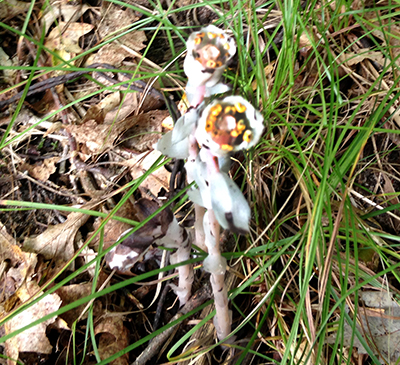Indian pipes: Oddities of the plant world
Indian pipes are a plant lacking chlorophyll that hitchhike with native Michigan trees like oaks.

When is a mushroom not a mushroom? The answer is when it is a “ghost plant.” The Michigan State University Extension lawn and garden hotline (1-888-678-3464) receives questions about many gardening subjects. Some of the oddest questions are stimulated by a quiet walk in the woods or park where people encounter plants of the weirdest kind.
One of the things that define a plant is that it can make its own food. The green pigment in the plant parts, primarily leaves, contains a substance known as chlorophyll that appears green. Chlorophyll contained in organelles known as “plastids” in the leaf is synonymous with life on earth – the chemical equation for photosynthesis is the source (byproduct) of the oxygen we breathe.
So when you come upon an odd collection of white-stemmed “plants,” one might ask is it really a plant, or am I in OZ? The answer may surprise you. Commonly known as Indian pipes, ghost plant and oddly enough, corpse plant, Monotropa uniflora are kind of an anomaly in the plant kingdom. Completely lacking chlorophyll, this plant makes life happen by “networking” with fungi relatives known as mycorrhizae and the roots of plants (trees) that are conducting photosynthesis. In short, these plants optimize their root relationship with the fungi that are uniquely connected to and fed by the green plant. Brilliant!
The short-in-stature plant features a single bloom on a single stem that has tiny leaves that are all white. Aptly named, M. uniflora is a relative of the common blueberry (Ericacea family), which has a very similar shaped bloom. It can actually grow in the darkest area of a woodlot since it needs no sunlight to survive. I usually find this plant growing in the root zone of oak woodlots, but it is also commonly found under maples.

The flower of Indian pipes, a relative of blueberries, opens upwards to encourage a pollinator.
You might think this is sort of cheating the system, but some sources claim that the hijacking of nutrients through a third party is not an offence to the tree that is busy making the food. Most of the literature cites that the trees don’t even notice since the mycorrhizae fungi are actually beneficial to them. It’s like the distant third cousins living in the apartment next door who drive a Ferrari and look really cool, but don’t ask for much. Huh – wish I could do that!
As it turns out, this is only one of about 3,000 non-photosynthetic plants in the world. Who would have thought? So, on your next walk through the woodlot, watch for this strange adaptation of nature and just enjoy it!
For more information on a wide variety of smart gardening topics, or to find out about smart gardening classes and events, visit www.migarden.msu.edu.



 Print
Print Email
Email